An Easily Used Phenomenological Magnetization Model and Its Empirical Expressions Based on Jiles–Atherton Parameters
Abstract
1. Introduction
2. Jiles–Atherton Hysteresis Model
2.1. Description and Solution
2.2. Key Characteristic Parameters in Time-Domain Performance
3. Response of First-Order Linear Time-Invariant (LTI) System
3.1. Description and Solution
3.2. Description of Magnetic Hysteresis by the First-Order LTI System Model
3.3. Introduction of Amplitude–Frequency Function
4. Simple Hysteresis Model
5. First-Order LTI System Sub-Model under Low Magnetic Field Intensity
5.1. Optimal Parameter for Amplitude
5.2. Empirical Equations for the Parameters
5.2.1. Function Format
5.2.2. Parameter Determination
- (1)
- Select one parameter as the independent variable and fix the other variables as any value. Calculate the magnetization values using the Jiles–Atherton model or any other verified hysteresis model based on the different values of the specified independent variable.
- (2)
- Extract the maximum value of magnetization Mmax and determine the equivalent phase lag φ via direct fitting.
- (3)
- Calculate the optimal values of R and L under variable parameters using Equation (7) based on the obtained Mmax and φ under different values of Hmax.
- (4)
- Determine the optimal values of AL, BL, CL, DR, and ER using the fitting method based on Equation (8).
- (5)
- Fit the functional relationship between the optimal values of AL, BL, CL, DR, and ER and the specified independent variable. The computational precision of amplitude is guaranteed with priority.
- (6)
- Change the selected variable, return to (1), and then repeat (1)–(6) to determine the functional relationship (univariate) between the optimal values of AL, BL, CL, DR, ER, and the other parameters.
- (7)
- Employ the linear combination method to transform multiple univariate functions into a multivariate function.
5.2.3. Verification under Fixed Values
5.2.4. Parameter Applicability
6. Nonlinear Simple Function Sub-Model under High Magnetic Field Intensity
6.1. Optimal Parameter for Amplitude
6.2. Empirical Equations for the Parameters
6.2.1. Function Format
6.2.2. Parameter Determination
6.2.3. Verification under Fixed Values
6.2.4. Parameter Applicability
7. A Simple Summary
8. On/Off Type Device—A Special Example
9. Conclusions
- (1)
- Neglecting the nonlinearity of anhysteretic magnetization, the first-order LTI system model was suitable for conditions with a magnetic field amplitude not higher than H0.5. Moreover, empirical expressions for parameters applicable to various materials were given based on univariate fitting and the linear combination of univariate functions. The proposed equations required the foreknowledge of the maximum and the increase in the magnetic field intensity, and they were approximately suitable for the parameter ranges k ∈ [1000, 4000], a ∈ [8000, 15,500], α ∈ [−0.01, 0.005], and c ∈ (0.1, 0.3). An error analysis showed good performance of the first-order LTI system model, as the calculation errors of the amplitudes were lower than 5%, and the precision of computing the phase lag was acceptable.
- (2)
- Neglecting the phase lag, the nonlinear function model was suitable under a magnetic field amplitude not lower than H0.5. The nonlinear function model had only one parameter and did not require any foreknowledge. Empirical equations for the parameters were given and suitable for the parameter ranges k ∈ [1000, 4000], a ∈ [5000, 20,000], α ∈ [−0.01, 0.002], and c ∈ (0, 1). The error analysis showed good performance of the nonlinear function model, as the calculation errors were lower than 5%.
- (3)
- Both the first-order LTI system model and the nonlinear function model can effectively predict the magnetization of the material employed in an on/off type device. Taking giant magnetostrictive material as an example, the two models with the parameters from the direct fitting or empirical equations showed acceptable calculation effects, as the relative errors when computing the amplitude were not higher than 5%, and the proportions of the responding time under all conditions were less than 6%. Furthermore, the first-order LTI system model with direct fitting parameters performed the best when computing the amplitude, with a relative error less than 1.5%, while the nonlinear function model was better in describing the response time when not introducing a time lag.
Author Contributions
Funding
Institutional Review Board Statement
Informed Consent Statement
Data Availability Statement
Conflicts of Interest
Appendix A

Appendix B
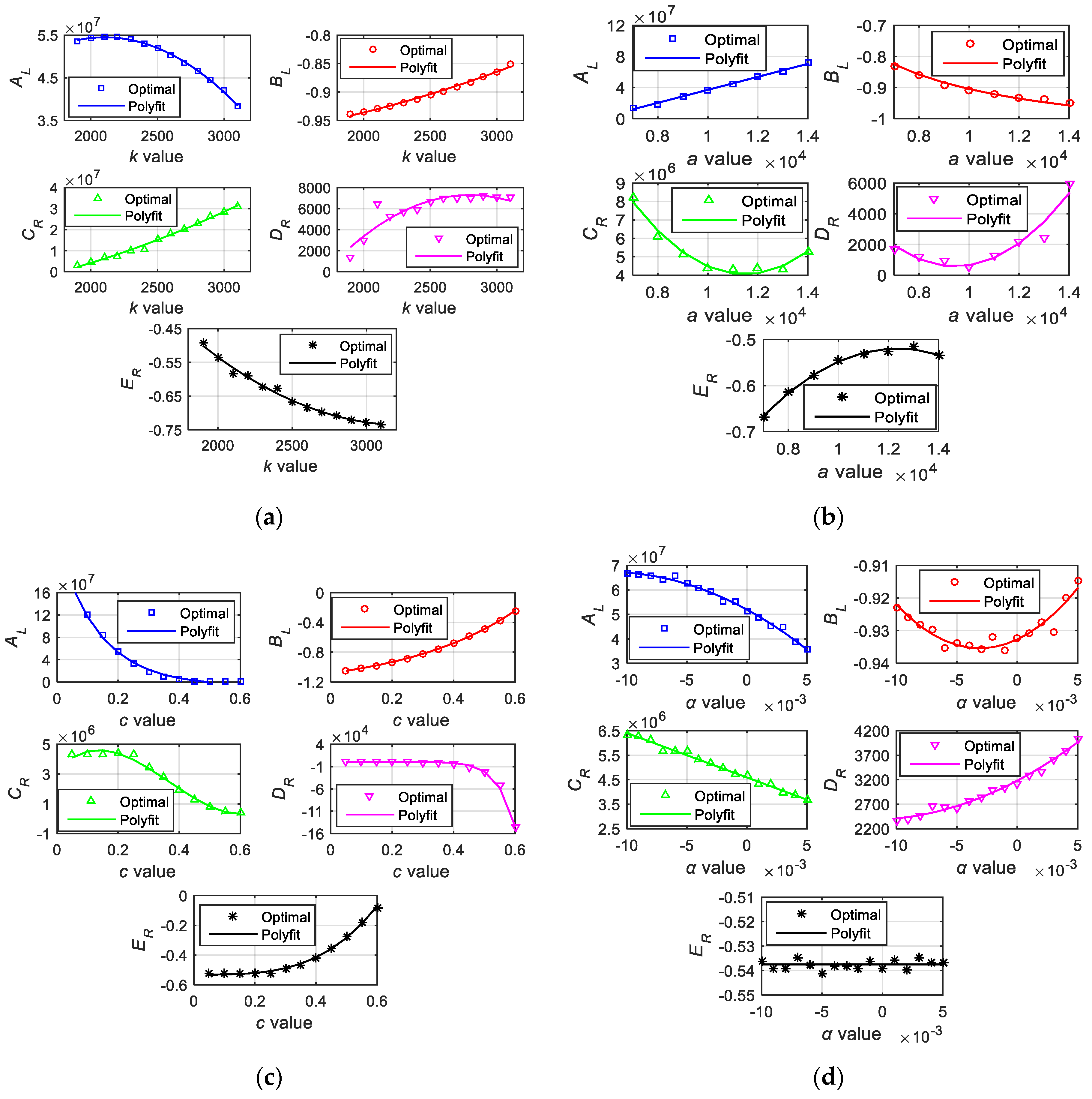
References
- Xiao, X.; Müller, F.; Bavendiek, G.; Hameyer, K. Analysis of vector hysteresis models in comparison to anhysteretic magnetization model. Eur. Phys. J. Appl. Phys. 2020, 91, 20901. [Google Scholar] [CrossRef]
- Roussel, R.; Edelen, A.; Ratner, D.; Dubey, K.; Gonzalez-Aguilera, J.P.; Kim, Y.K.; Kuklev, N. Differentiable Preisach Modeling for Characterization and Optimization of Particle Accelerator Systems with Hysteresis. Phys. Rev. Lett. 2022, 128, 204801. [Google Scholar] [CrossRef]
- Li, Y.; Zhu, J.; Zhu, L.; Li, Y.; Lei, G. A Dynamic Magnetostriction Model of Grain-Oriented Sheet Steels Based on Becker–Döring Crystal Magnetization Model and Jiles–Atherton Theory of Magnetic Hysteresis. IEEE Trans. Magn. 2020, 56, 1–5. [Google Scholar] [CrossRef]
- Xie, W.; Liu, Y.-H.; Wen, H.-H. Generalized phenomenological model for the magnetic field penetration and magnetization hysteresis loops of a type-II superconductor. PhRvB 2022, 105, 014505. [Google Scholar] [CrossRef]
- Chen, W.; Zhou, L.; Wang, J.; Zhao, Z.; Chen, W.; Bai, S. A Maxwell-Slip Based Hysteresis Model for Nonlinear Stiffness Compliant Actuators. ITIE 2022, 69, 11510–11520. [Google Scholar] [CrossRef]
- Tian, M.; Li, H.; Zhang, H. Neural Network Model for Magnetization Characteristics of Ferromagnetic Materials. IEEE Access 2021, 9, 71236–71243. [Google Scholar] [CrossRef]
- Shi, P. A Nonlinear Theoretical Model of Magnetization and Magnetostriction for Ferromagnetic Materials under Applied Stress and Magnetic Fields. Chin. Phys. Lett. 2020, 37, 087502. [Google Scholar] [CrossRef]
- Wang, W.; Wang, J.; Chen, Z.; Wang, R.; Lu, K.; Sang, Z.; Ju, B. Research on Asymmetric Hysteresis Modeling and Compensation of Piezoelectric Actuators with PMPI Model. Micromachines 2020, 11, 357. [Google Scholar] [CrossRef]
- Li, D.; Qiao, Z.; Wu, Y.; Li, Z.; Song, Y.; Li, Y. Three-Dimensional Magnetic Hysteresis Modeling Based on Vector Hysteresis Operator. IEEE Access 2021, 9, 144624–144633. [Google Scholar] [CrossRef]
- Hu, K.; Ge, H.; Li, H.; Xie, S.; Xu, S. Rate-Dependent Hysteresis Modeling and Displacement Tracking Control Based on Least-Squares SVM for Axially Pre-Compressed Macro-Fiber Composite Bimorph. Materials 2022, 15, 6480. [Google Scholar] [CrossRef]
- Klemenc, J.; Šeruga, D.; Nagode, A.; Nagode, M. Comprehensive Modelling of the Hysteresis Loops and Strain–Energy Density for Low-Cycle Fatigue-Life Predictions of the AZ31 Magnesium Alloy. Materials 2019, 12, 3692. [Google Scholar] [CrossRef]
- Minorowicz, B.; Milecki, A. Design and Control of Magnetic Shape Memory Alloy Actuators. Materials 2022, 15, 4400. [Google Scholar] [CrossRef]
- Jiles, D.C.; Atherton, D.L. Ferromagnetic hysteresis. IEEE Trans. Magn. 1983, 19, 2183–2185. [Google Scholar] [CrossRef]
- Jiles, D.C.; Atherton, D.L. Theory of ferromagnetic hysteresis. J. Magn. Magn. Mater. 1986, 61, 48–60. [Google Scholar] [CrossRef]
- Jiles, D.C.; Atherton, D.L. Theory of ferromagnetic hysteresis (invited). J. Appl. Phys. 1984, 55, 2115–2120. [Google Scholar] [CrossRef]
- Rupnik, U.; Alić, A.; Miljavec, D. Harmonization and Validation of Jiles–Atherton Static Hysteresis Models. Energies 2022, 15, 6760. [Google Scholar] [CrossRef]
- Coelho, L.D.S.; Mariani, V.C.; Leite, J.V. Solution of Jiles–Atherton vector hysteresis parameters estimation by modified Differential Evolution approaches. Expert Syst. Appl. 2012, 39, 2021–2025. [Google Scholar] [CrossRef]
- Xue, G.; Zhang, P.; He, Z.; Li, D.; Yang, Z.; Zhao, Z. Modification and NumericalMethod for the Jiles–Atherton HysteresisModel. Commun. Comput. Phys. 2017, 21, 763–781. [Google Scholar] [CrossRef]
- Xue, G.; Zhang, P.; He, Z.; Li, D. Approximation of anhysteretic magnetization and fast solving method for Jile-Atherton hysteresis equation. Ferroelectrics 2016, 502, 197–209. [Google Scholar] [CrossRef]
- Smith, R.C.; Dapino, M.J.; Seelecke, S. Free energy model for hysteresis in magnetostrictive transducers. J. Appl. Phys. 2003, 93, 458–466. [Google Scholar] [CrossRef]
- Yu, Z.; Zhang, C.-Y.; Yu, J.-X.; Dang, Z.; Zhou, M. Construction and Numerical Realization of a Magnetization Model for a Magnetostrictive Actuator Based on a Free Energy Hysteresis Model. Appl. Sci. 2019, 9, 3691. [Google Scholar] [CrossRef]
- Tian, C.; Wang, H. Investigation of optimal method for free energy hysteresis model in giant magnetostrictive actuators. China Mech. Eng. 2005, 16, 24–27. [Google Scholar]
- Shu, L.; Chen, D.; Lu, Q.; Huang, Z. Modeling of time-delay in giant magnetostrictive actuator and smith strategy. J. Syst. Simul. 2009, 21, 3017–3021. [Google Scholar]
- Preisach, F. Uber die magnetische nachwrikung. Z. Phys. 1935, 94, 277–302. [Google Scholar] [CrossRef]
- Wang, X.; Hong, H.; Su, C. Adaptive robust control of dynamic systems with unknown input hysteresis. In Proceedings of the Fourth International Conference on Control and Automation (ICCA’03), Montreal, QC, Canada, 12 June 2003; pp. 138–142. [Google Scholar]
- Boley, C.D.; Hodgdon, M.L. Model and simulations of hysteresis in magnetic cores. IEEE Trans. Magn. 1989, 25, 3922–3924. [Google Scholar] [CrossRef]
- Makaveev, D.; Dupre’, L.; Wulf, M.D.; Melkebeek, J. Modeling of quasistatic magnetic hysteresis with feed-forward neural networks. J. Appl. Phys. 2001, 89, 6737–6739. [Google Scholar] [CrossRef]
- Abdelmadjid, N.; Elamine, N.; Mouloud, F. Neural network-DFT based model for magnetostrictive hysteresis. Int. J. Appl. Electrom. 2013, 42, 343–348. [Google Scholar] [CrossRef]
- Kucuk, I. Prediction of hysteresis loop in magnetic cores using neural network and genetic algorithm. J. Magn. Magn. Mater. 2006, 305, 423–427. [Google Scholar] [CrossRef]
- Liu, H.; Jia, Z.; Wang, F. Study on hysteresis model of giant magnetostrictive sensing actuator based on neural network. China Mech. Eng. 2011, 22, 571–575. [Google Scholar]
- Yang, C.; Fan, J. Artificial neural network-based hysteresis model for circular steel tubes. Structures 2021, 30, 418–439. [Google Scholar] [CrossRef]
- Armstrong, W.D. An incremental theory of magneto-elastic hysteresis in pseudo-cubic ferro-magnetostrictive alloys. J. Magn. Magn. Mater. 2003, 263, 208–218. [Google Scholar] [CrossRef]
- Armstrong, W.D. Magnetization and magnetostriction processes in Tb(0.27–0.30)Dy(0.73–0.70)Fe(1.9–2.0). J. Appl. Phys. 1997, 81, 2321–2326. [Google Scholar] [CrossRef]
- Wen, Y.K. Method for random vibration of hysteretic systems. J. Eng. Mech. Div. 1976, 102, 249–263. [Google Scholar] [CrossRef]
- Li, H.; Meng, G. Nonlinear dynamics of a SDOF oscillator with Bouc-Wen hysteresis. Chaos Soliton. Fract. 2007, 34, 337–343. [Google Scholar] [CrossRef]
- Yu, Z.; Rao, G.; Huo, T.; Chen, D. Polynomial fitting curve for output properties of micro-driver based on GMM. J. Magn. Mater. Devices 2016, 47, 22–26. [Google Scholar]
- Krasnosel’skiǐ, M.A.; Pokrovskiǐ, A.V. Systems with Hysteresis; Springer: Berlin/Heidelberg, Germany, 1989. [Google Scholar]
- Zhang, Z.; Mao, J.; Zhou, K. Experimental characterization and modeling of stress-dependent hysteresis of a giant magnetostrictive actuator. Sci. China-Technol. Sci. 2013, 56, 656–665. [Google Scholar] [CrossRef]
- Kuhnen, K. Modeling, identification and compensation of complex hysteretic nonlinearities—A modified Prandtl-Ishlinskii approach. Eur. J. Control 2003, 9, 407–418. [Google Scholar] [CrossRef]
- Xue, G.; Zhang, P.; Li, X.; He, Z.; Wang, H.; Li, Y.; Ce, R.; Zeng, W.; Li, B. A review of giant magnetostrictive injector (GMI). Senss. Actuat. A-Phys. 2018, 273, 159–181. [Google Scholar] [CrossRef]
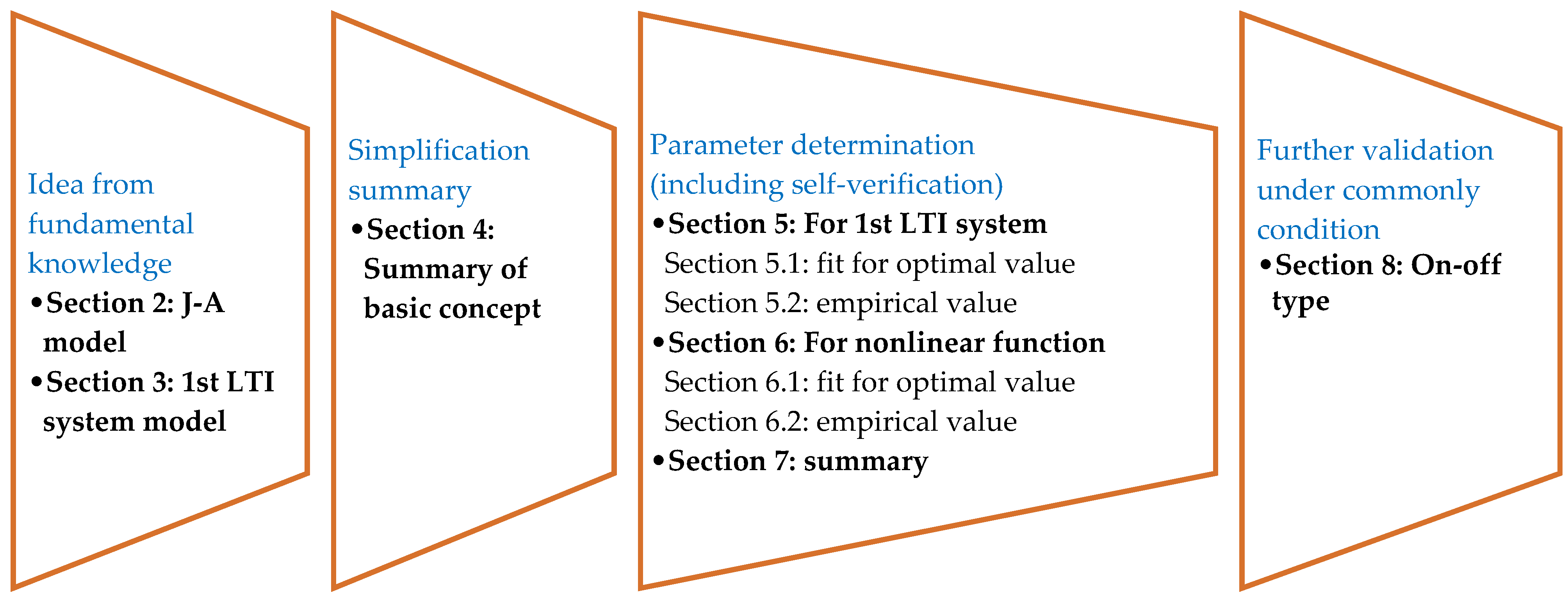
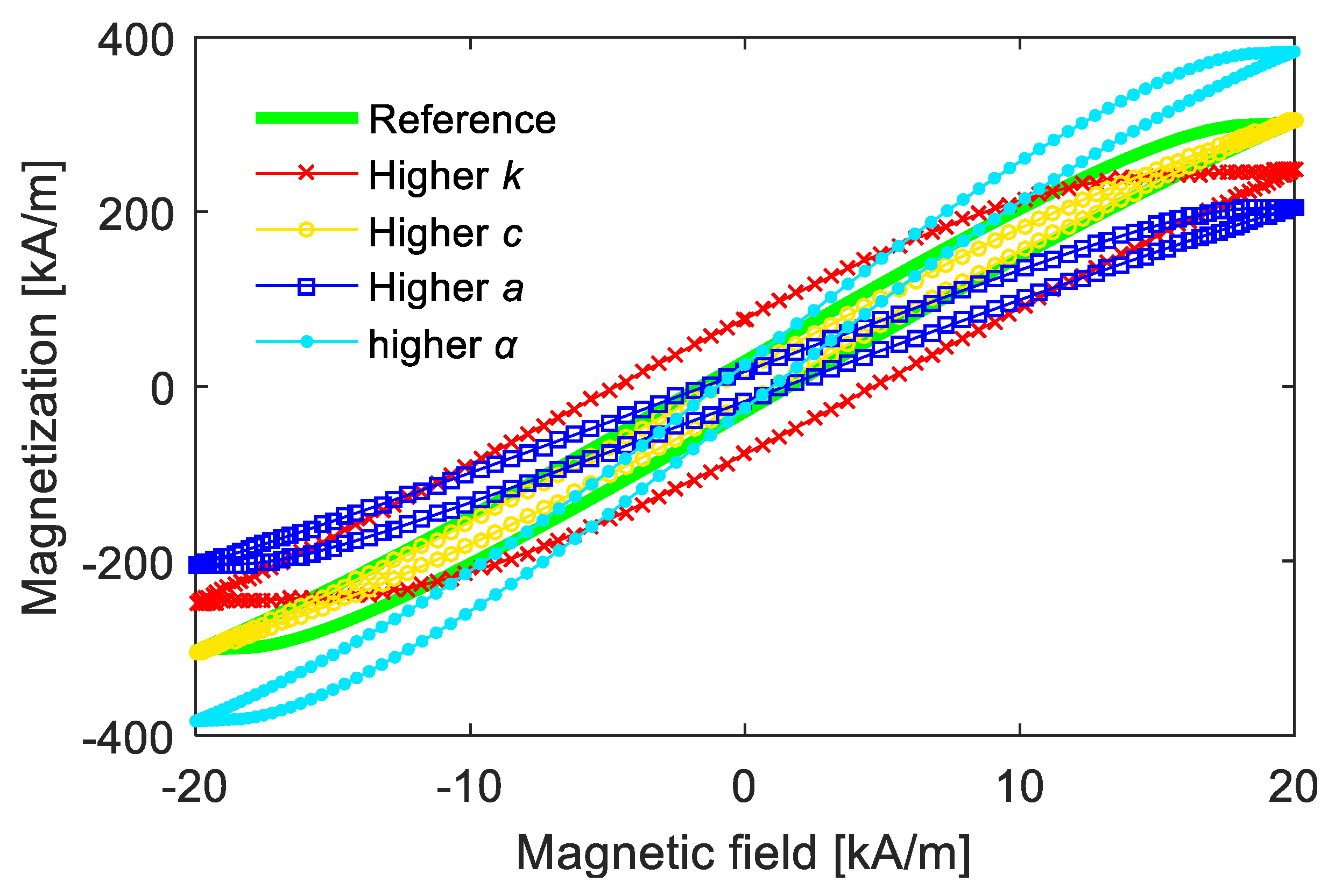
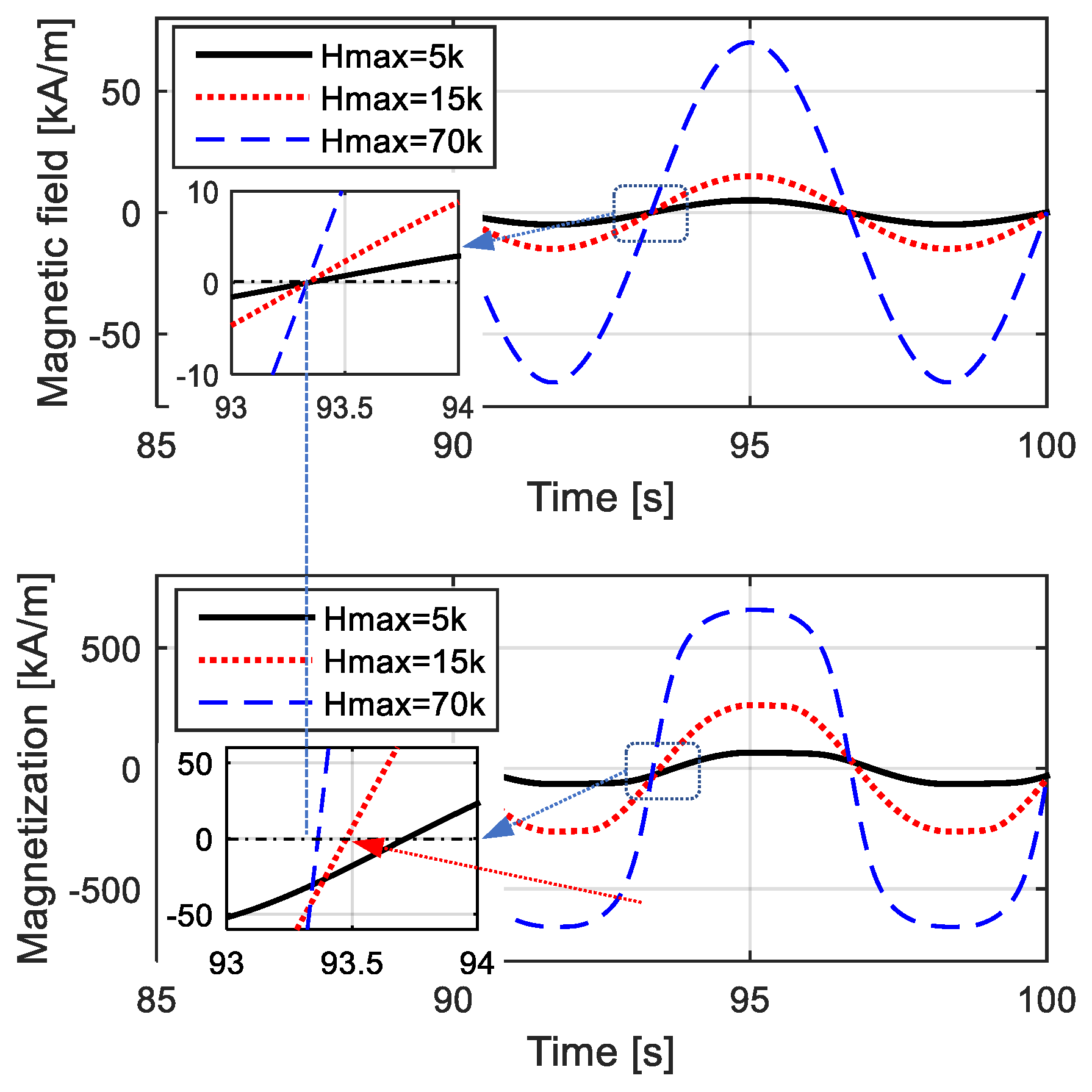
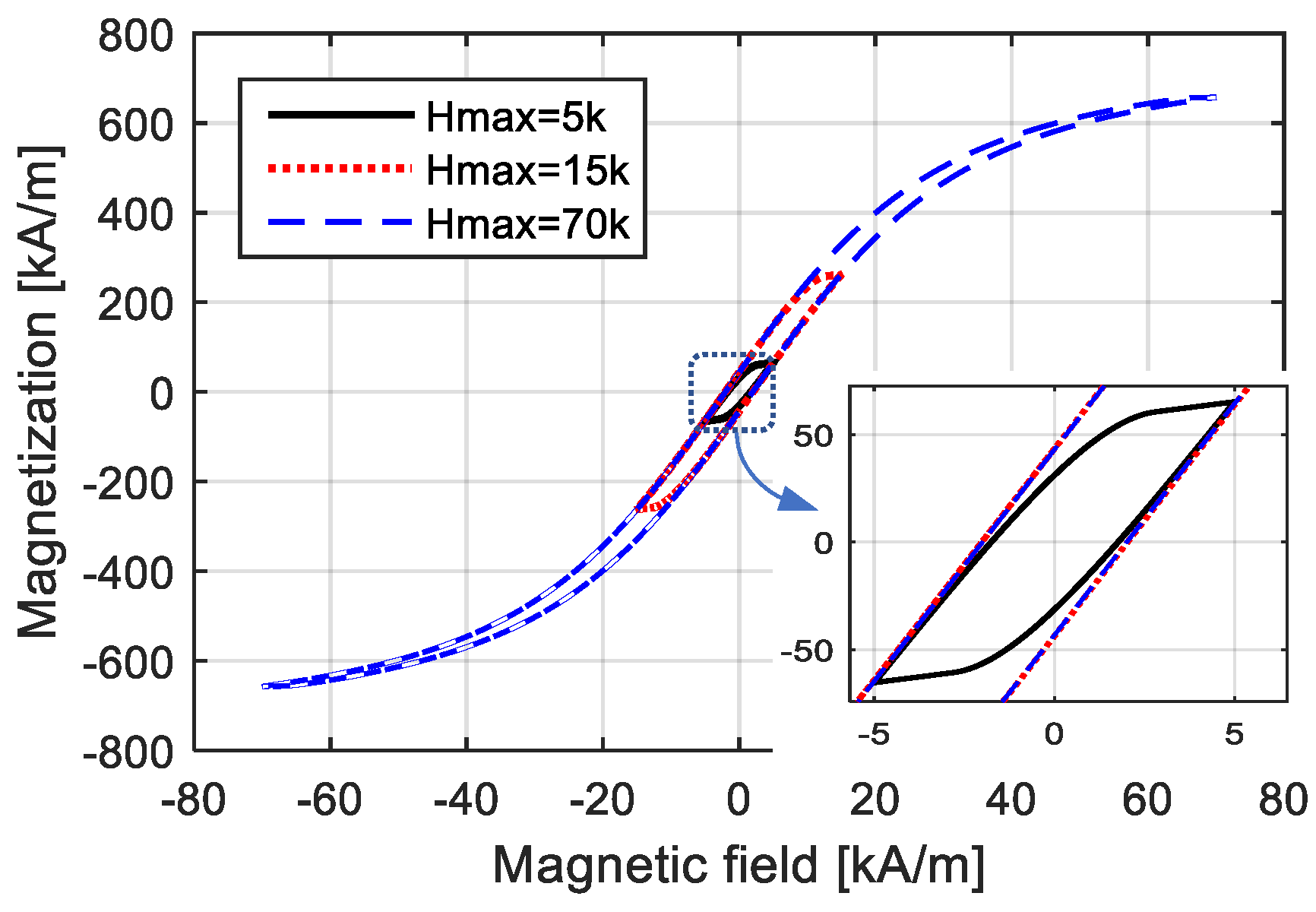



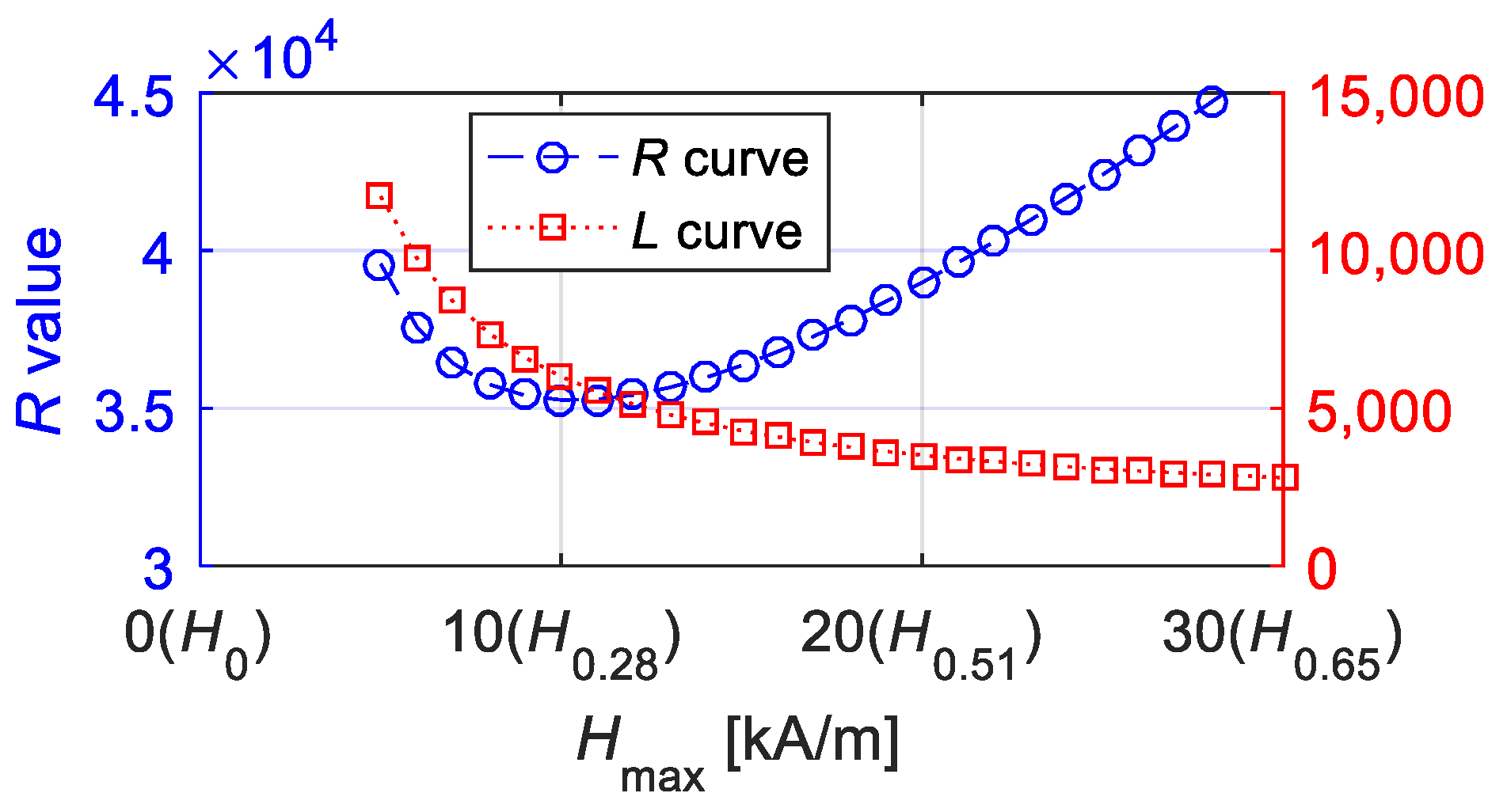
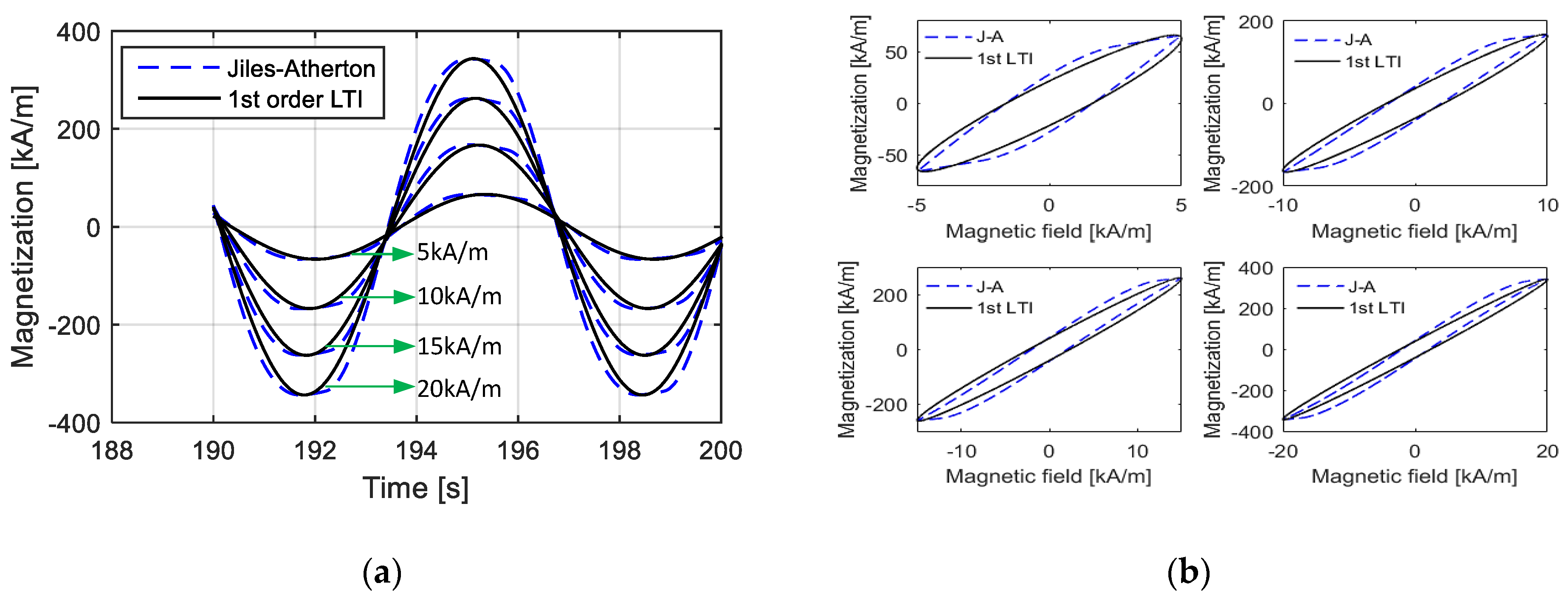

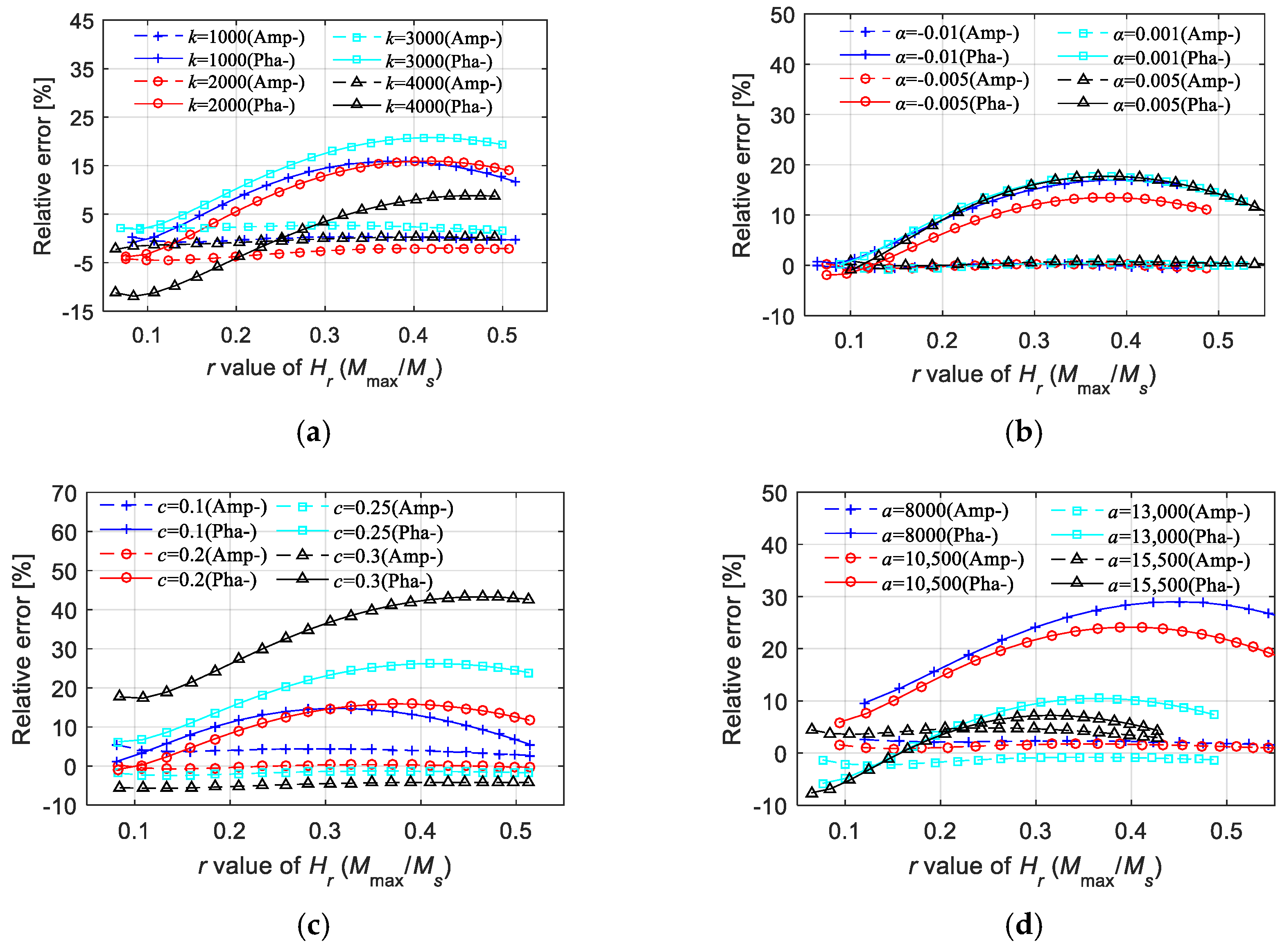
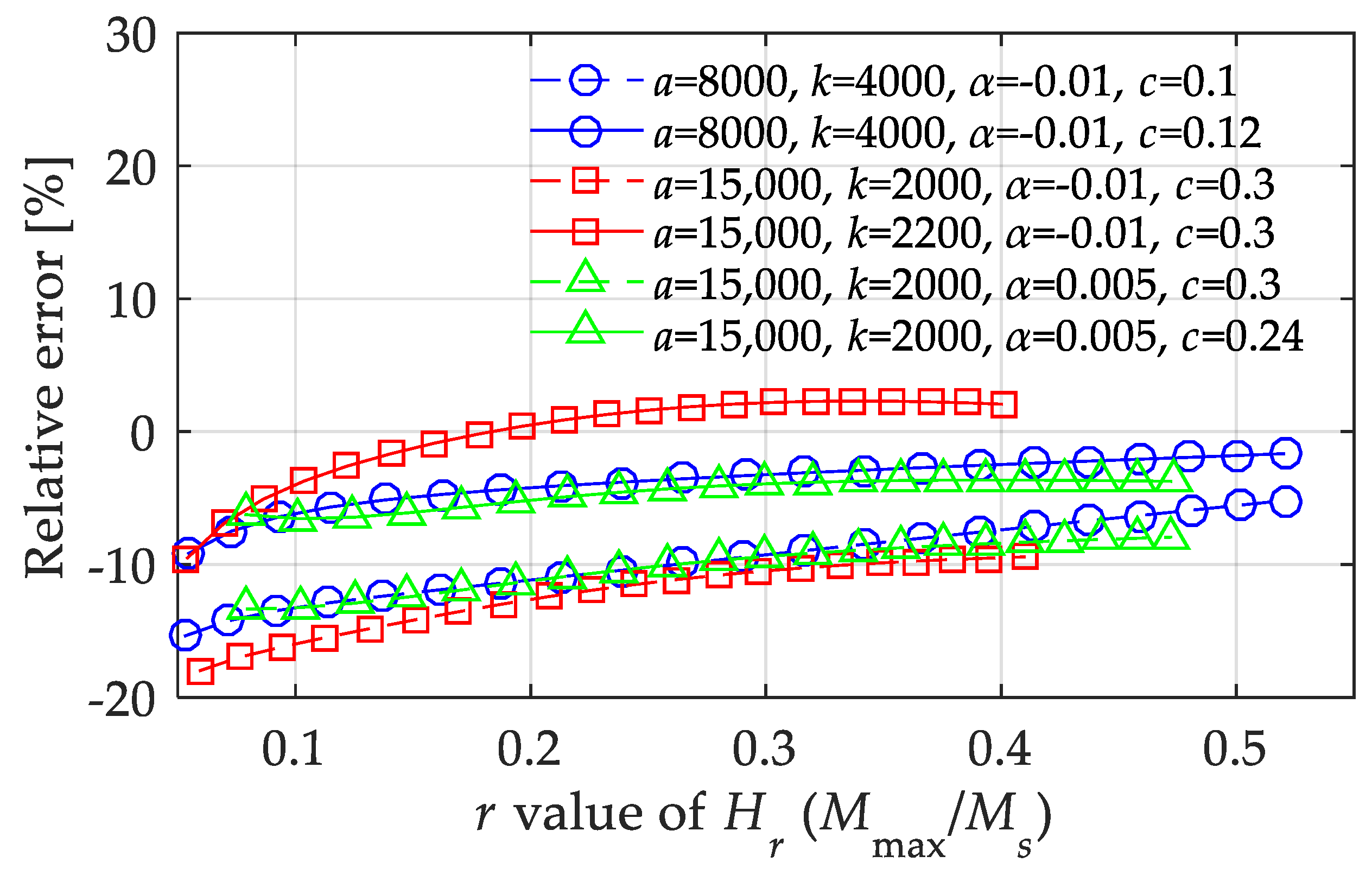
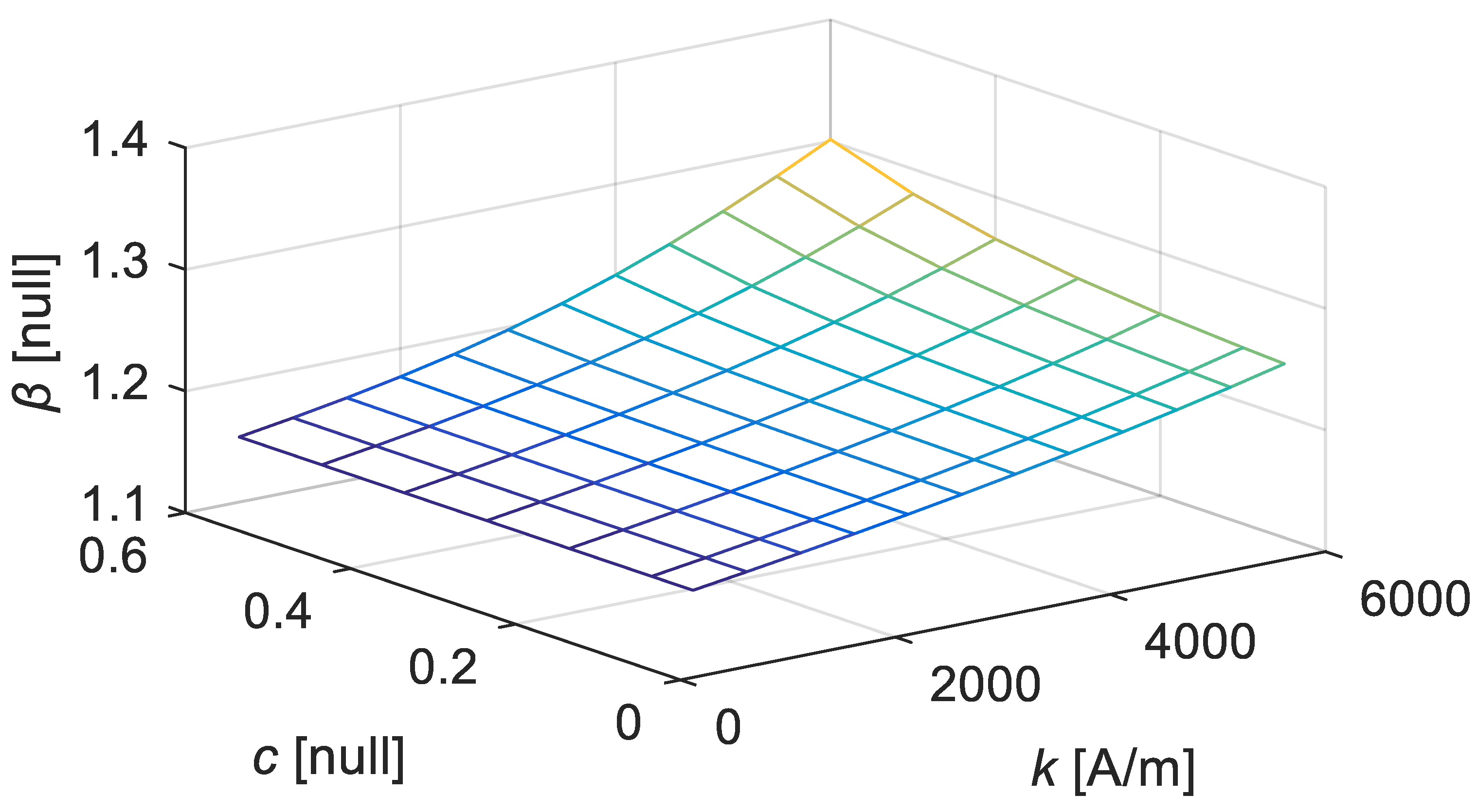

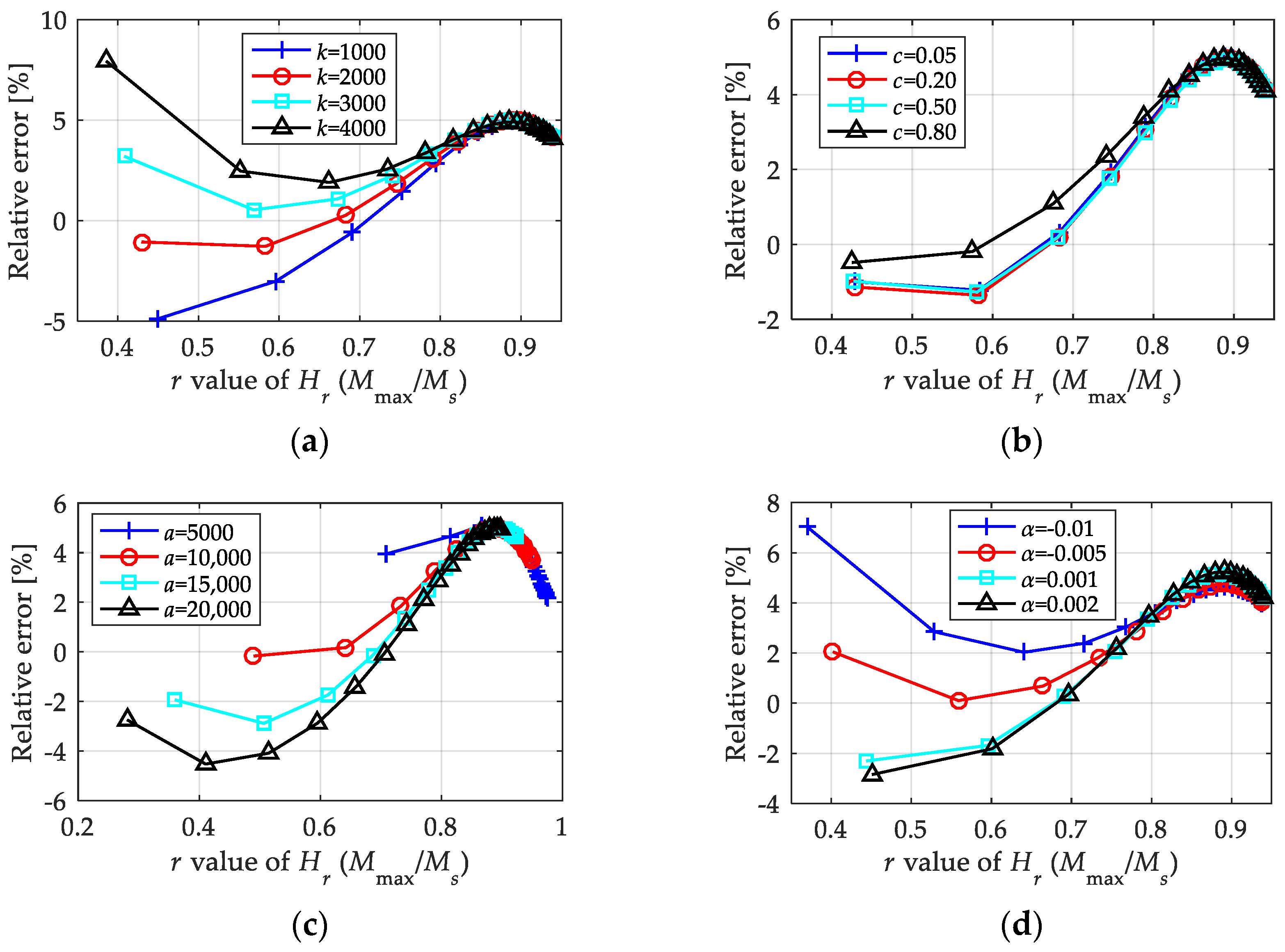


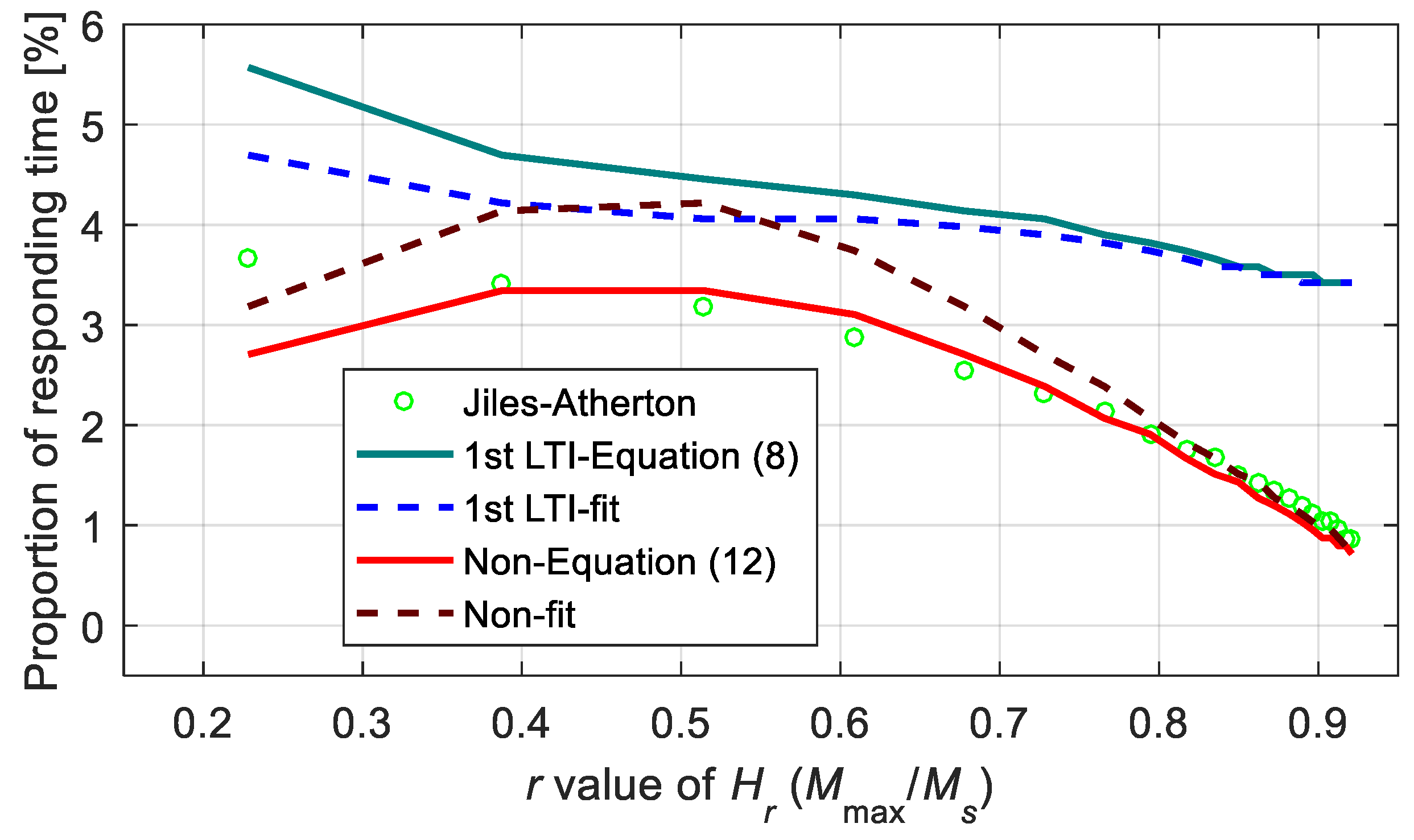
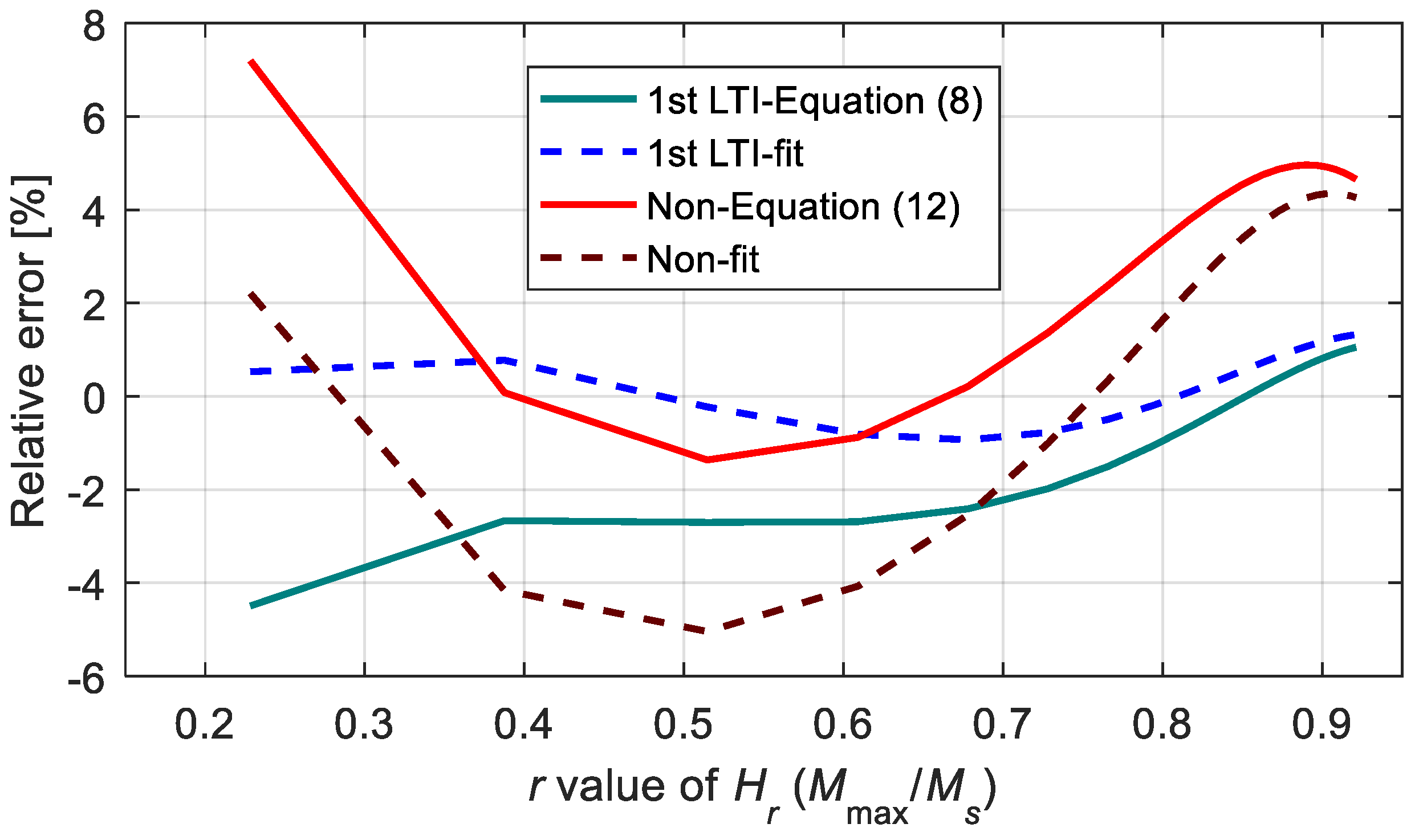
| Conditions | Area of Hysteretic Loop [kA2/m2] | Relative Error [%] | |
|---|---|---|---|
| J–A Model | 1st-Order LTI Model | ||
| Hmax = 5 kA/m | 350.6 | 337.9 | 3.63 |
| Hmax = 10 kA/m | 1160.1 | 1122.9 | 3.21 |
| Hmax = 15 kA/m | 1924.5 | 1898.1 | 1.37 |
| Hmax = 20 kA/m | 2581.6 | 2478.5 | 3.99 |
| Jiles–Atherton Model | 1st-Order LTI Model with Empirical Parameters | 1st-Order LTI Model with Fitted Parameters | Nonlinear Model with Empirical Parameters | ||||
|---|---|---|---|---|---|---|---|
| Parameter | Value | Parameter | Value | Parameter | Value | Parameter | Value |
| α [null] | −0.001 | AL [A·s/m] | 6.355 × 107 | AL [A·s/m] | 1.933 × 107 | Kan [A/m] | 4.278 × 104 |
| k [A/m] | 2200 | BL [null] | −0.937 | BL [null] | −0.807 | ||
| c [null] | 0.18 | CR [A/m] | 8.973 × 106 | CR [A/m] | 6.545 × 106 | Nonlinear Model with Fitted Parameters | |
| a [A/m] | 12,000 | DR [A/m] | 4627 | DR [A/m] | 4071 | ||
| Ms [A/m] | 8 × 105 | ER [null] | −0.6 | ER [null] | −0.572 | Parameter | Value |
| ωL | 40 | ωL | 40 | Kan [A/m] | 4.5 × 104 | ||
Publisher’s Note: MDPI stays neutral with regard to jurisdictional claims in published maps and institutional affiliations. |
© 2022 by the authors. Licensee MDPI, Basel, Switzerland. This article is an open access article distributed under the terms and conditions of the Creative Commons Attribution (CC BY) license (https://creativecommons.org/licenses/by/4.0/).
Share and Cite
Xue, G.; Bai, H.; Li, T.; Lu, C. An Easily Used Phenomenological Magnetization Model and Its Empirical Expressions Based on Jiles–Atherton Parameters. Materials 2022, 15, 7592. https://doi.org/10.3390/ma15217592
Xue G, Bai H, Li T, Lu C. An Easily Used Phenomenological Magnetization Model and Its Empirical Expressions Based on Jiles–Atherton Parameters. Materials. 2022; 15(21):7592. https://doi.org/10.3390/ma15217592
Chicago/Turabian StyleXue, Guangming, Hongbai Bai, Tuo Li, and Chunhong Lu. 2022. "An Easily Used Phenomenological Magnetization Model and Its Empirical Expressions Based on Jiles–Atherton Parameters" Materials 15, no. 21: 7592. https://doi.org/10.3390/ma15217592
APA StyleXue, G., Bai, H., Li, T., & Lu, C. (2022). An Easily Used Phenomenological Magnetization Model and Its Empirical Expressions Based on Jiles–Atherton Parameters. Materials, 15(21), 7592. https://doi.org/10.3390/ma15217592








